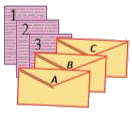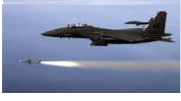Complete Solutions to Example of chapter INTRODUCTION TO PROBABILITY THEORY of Class 11 book with complete answers and questions
| Class 11 | MATHS |
| Chapter | INTRODUCTION TO PROBABILITY THEORY |
| TAMILNADU GOVT | Example |
| Number Of Questions | 33 |
| Academic Year | 2023-24 |
If an experiment has exactly the three possible mutually exclusive outcomes A, B, and C, check in each case whether the assignment of probability is permissible.
`P(A)=(4)/(7), " " P(B)=(1)/(7), " " P(C)=(2)/(7)`.View SolutionIf an experiment has exactly the three possible mutually exclusive outcomes A, B, and C, check in each case whether the assignment of probability is permissible.
`P(A)=(2)/(5), " " P(B)=(1)/(5) , " " P(C)=(3)/(5)`.View SolutionIf an experiment has exactly the three possible mutually exclusive outcomes A, B, and C, check in each case whether the assignment of probability is permissible.
`P(A)=0.3, " " P(B)=0.9, " " P(C)=-0.2`.View SolutionIf an experiment has exactly the three possible mutually exclusive outcomes A, B, and C, check in each case whether the assignment of probability is permissible.
`P(A)=(1)/(sqrt(3)), " "P(B)=1-(1)/(sqrt(3)), " " P(C)=0`View SolutionIf an experiment has exactly the three possible mutually exclusive outcomes A, B, and C, check in each case whether the assignment of probability is permissible.
`P(A)=0.421, " " P(B)=0.527 " " P(C)=0.042`.View SolutionAn integer is chosen at random from the first ten positive integers. Find the probability that it is (i) an even number (ii) multiple of three.
View SolutionThree coins are tossed simultaneously, what is the probability of getting (i) exactly one head (ii) at least one head (iii) at most one head?
View SolutionSuppose ten coins are tossed. Find the probability to get (i) exactly two heads (ii) at most two heads (iii) at least two heads
View SolutionSuppose a fair die is rolled. Find the probability of getting (i) an even number (ii) multiple of three.
View SolutionWhen a pair of fair dice is rolled, what are the probabilities of getting the sum
(i) 7
(ii) 7 or 9
(iii) 7 or 12 ?View SolutionThree candidates X, Y, and Z are going to play in a chess competition to win FIDE (World Chess Federation) cup this year. X is thrice as likely to win as Y and Y is twice as likely as to win Z. Find the respective probability of X, Y and Z to win the cup.
View SolutionThree letters are written to three different persons and addresses on three envelopes are also written. Without looking at the addresses, what is the probability that (i) exactly one letter goes to the right envelopes (ii) none of the letters go into the right envelopes?
 View Solution
View SolutionLet the matrix `[{:(x,y),(z,1):}]` . If x y zare chosen at random from the set `{1,2,3}`, and repetition is allowed (I,e.,x=y =z ) what is the probability that the given matrix M is a singular matrix?
View SolutionFor a sports meet, a winners’ stand comprising of three wooden blocks is in the form as shown in figure. There are six different colours available to choose from and three of the wooden blocks is to be painted such that no two of them has the same colour. Find the probability that the smallest block is to be painted in red, where red is one of the six colours.
 View Solution
View SolutionA man has 2 ten rupee notes, 4 hundred rupee notes and 6 five hundred rupee notes in his pocket. If 2 notes are taken at random, what are the odds in favour of both notes being of hundred rupee denomination and also its probability?
View SolutionNine coins are tossed once, find the probability to get at least two heads.
View SolutionGiven that P(A) = 0.52, P(B) = 0.43, and `P(capB)=0.24`, find
`P(Acapoverline(B))`View SolutionGiven that P(A) = 0.52, P(B) = 0.43, and `P(capB)=0.24`, find
`P(AuuB)`View SolutionGiven that P(A) = 0.52, P(B) = 0.43, and `P(capB)=0.24`, find
`P(overline(A)capoverline(B))`View SolutionGiven that P(A) = 0.52, P(B) = 0.43, and `P(capB)=0.24`, find
`P(overline(A)uuoverline(B))`.View SolutionIf `P(A)=0.6," " P(B)=0.5, and P(AcapB)=0.2` Find
`P(A//B)`View SolutionIf `P(A)=0.6," " P(B)=0.5, and P(AcapB)=0.2` Find
`P(overline(A)//B)`View SolutionIf `P(A)=0.6," " P(B)=0.5, and P(AcapB)=0.2` Find
`P(A//overline(B))`.View SolutionA die is rolled. If it shows an odd number, then find the probability of getting 5.
View SolutionTwo cards are drawn from a pack of 52 cards in succession. Find the probability that both are Jack when the first drawn card is (i) replaced (ii) not replaced
View SolutionIf A and B are two independent events such that `P(A)=0.4andP(AuuB)=0.9`.Find P(B).
View SolutionAn anti-aircraft gun can take a maximum of four shots at an enemy plane moving away from it. The probability of hitting the plane in the first, second, third, and fourth shot are respectively 0.2, 0.4, 0.2 and 0.1. Find the probability that the gun hits the plane.
 View Solution
View SolutionX speaks truth in 70 percent of cases, and Y in 90 percent of cases. What is the probability that they likely to contradict each other in stating the same fact?
View SolutionUrn-I contains 8 red and 4 blue balls and urn-II contains 5 red and 10 blue balls. One urn is chosen at random and two balls are drawn from it. Find the probability that both balls are red
View SolutionA factory has two machines I and II. Machine-I produces 40% of items of the output and Machine-II produces 60% of the items. Further 4% of items produced by Machine-I are defective and 5% produced by Machine-II are defective. If an item is drawn at random, find the probability that it is a defective item
View SolutionA factory has two machines I and II. Machine I produces 40% of items of the output and Machine II produces 60% of the items. Further 4% of items produced by Machine I are defective and 5% produced by Machine II are defective. An item is drawn at random. If the drawn item is defective, find the probability that it was produced by Machine II. (See the previous example, compare the questions).
View SolutionThe chances of X, Y and Z becoming managers of a certain company are 4 : 2 : 3. The probabilities that bonus scheme will be introduced if X, Y and Z become managers are 0.3, 0.5 and 0.4 respectively. If the bonus scheme has been introduced, what is the probability that Z was appointed as the manager?
View SolutionA consulting firm rents car from three agencies such that 50% from agency L, 30% from agency M and 20% from agency N. If 90% of the cars from L, 70% of cars from M and 60% of the cars from N are in good conditions (i) what is the probability that the firm will get a car in good condition? (ii) if a car is in good condition, what is probability that it has come from agency N?
View Solution
Example questions and complete solutions for chapter INTRODUCTION TO PROBABILITY THEORY of FULL MARKS MATHEMATICS(TAMIL) of Class 11
